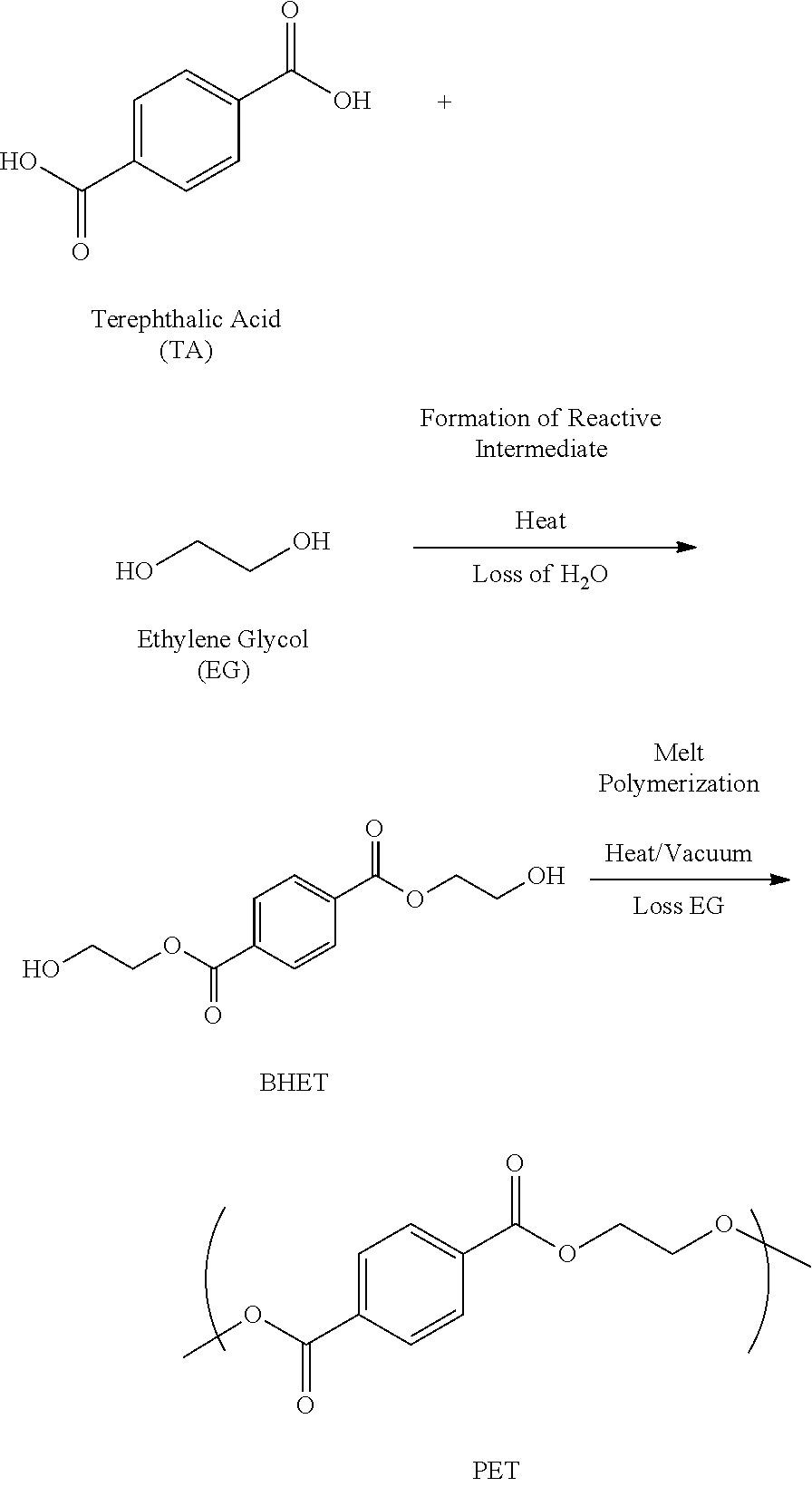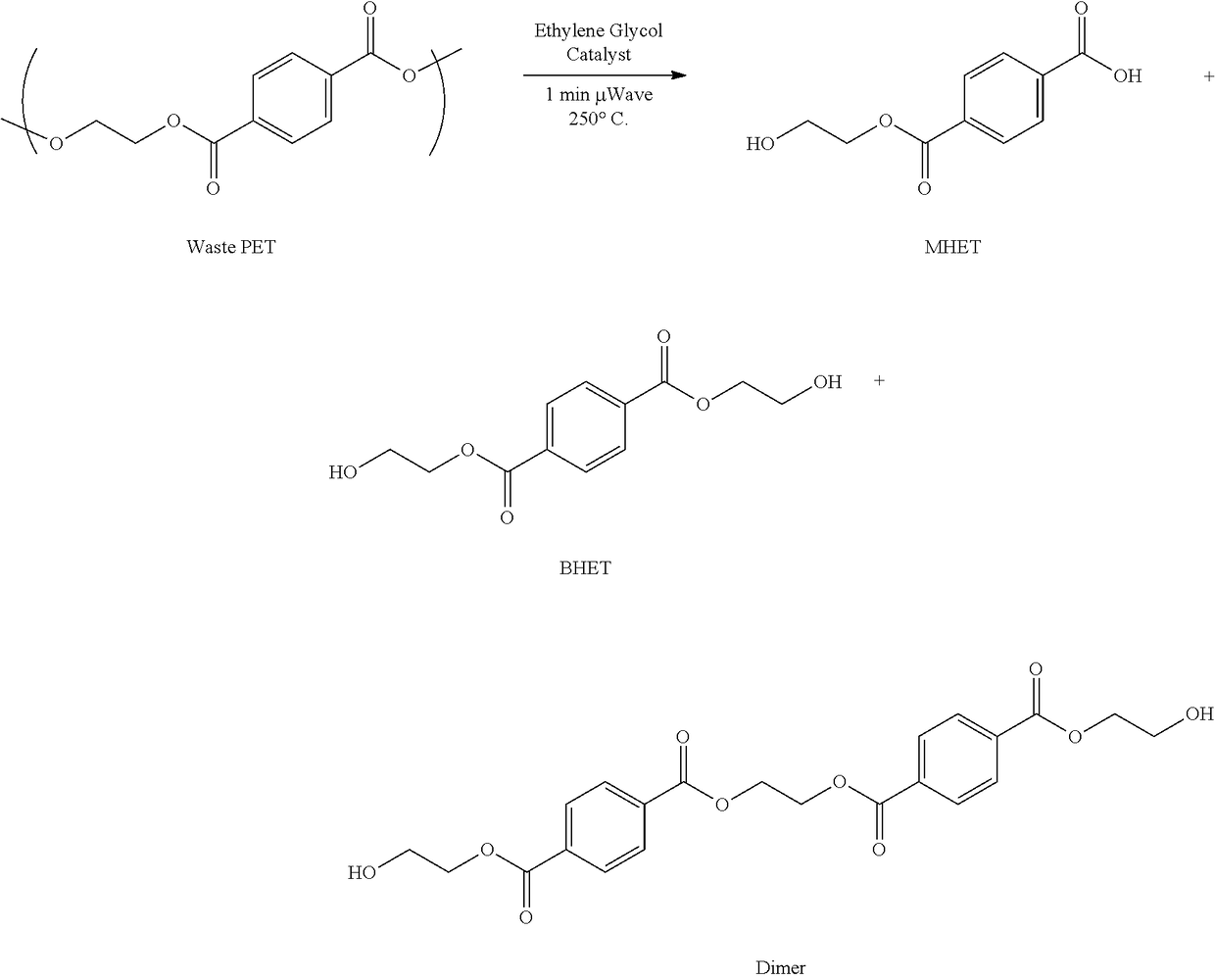Chemical recycling of polyethylene terephthalate by microwave irradiation
a technology of polyethylene terephthalate and chemical recycling, which is applied in the direction of organic chemistry, chemical apparatus and processes, and separation/purification of carboxylic acid esters, etc., can solve the problems of increasing environmental burden, increasing demand, and cost prohibitive pet recycling via glycolysis, so as to achieve more energy efficiency
- Summary
- Abstract
- Description
- Claims
- Application Information
AI Technical Summary
Benefits of technology
Problems solved by technology
Method used
Image
Examples
example 1
[0024]Example 1 demonstrates the effect of catalyst selection and catalyst concentration on the reaction efficiency of glycolytic depolymerization of PET to BHET. From a reaction standpoint, glycolytic depolymerization of PET is most efficient when the yield of BHET is maximized and the yield of MHET is minimized. The following catalysts were screened for their efficiency at depolymerizing PET into BHET: imidazole, triethyl amine (TEA), pyridine, antimony oxide, copper acetate, sodium carbonate, sodium bicarbonate, sodium acetate, manganese acetate, 1,5,7-triazabicyclo[4.4.0]dec-5-ene (TBD), 1,8-diazabicyclo[5.4.0]undec-7-ene (DBU), magnesium acetate, 4-dimethylaminopyridine (DMAP), zinc chloride and zinc acetate. As shown below, it was discovered that the yield of BHET from glycolytic depolymerization of PET is dependent on the particular catalyst being utilized, the concentration of the catalyst, and the duration of microwave irradiation.
[0025]For this investigation, pcPET flakes ...
example 2
[0028]Example 2 demonstrates the effect of ethylene glycol concentration on the reaction efficiency of glycolytic depolymerization of PET to BHET. Generic reaction conditions were used to identify the minimal amount of solvent required for the fast and efficient depolymerization of pcPET. The following standard reaction conditions were used: 0.4 wt % catalyst (i.e. 2 mg of catalyst for 0.5 g of PET or 4 mg of catalyst for 1 g PET), 5 mL ethylene glycol, 1 minute microwave reaction (high absorption) at 250° C., and variable amounts of post-consumer PET. Specifically, the following ratios of ethylene glycol (volume) to PET (weight) were investigated: 20:1 (5 mL EG:250 mg PET), 10:1 (5 mL EG:500 mg PET), 8:1 (5 mL EG:625 mg PET), 6:1 (5 mL EG:833 mg PET), 5:1 (5 mL EG:1 g PET), 4:1 (5 mL EG:1.25 g PET). Each ratio was run in triplicate and each reaction was analyzed by HPLC. The effect of ethylene glycol concentration on the yield of BHET, MHET, and BHET dimer are reported in Table 3:
T...
example 3
[0029]Example 3 demonstrates the effect of catalyst selection on both reaction efficiency and overall energy consumption during glycolytic depolymerization of PET. The wattage, time, and watt-hours of the glycolytic depolymerization reaction using the following catalysts were investigated: imidazole, triethyl amine (TEA), pyridine, antimony oxide, copper acetate, sodium carbonate, sodium bicarbonate, sodium acetate, manganese acetate, 1,5,7-triazabicyclo[4.4.0]dec-5-ene (TBD), 1,8-diazabicyclo[5.4.0]undec-7-ene (DBU), magnesium acetate, 4-dimethylaminopyridine (DMAP), zinc chloride and zinc acetate. Electricity usage was monitored using a P3-International “Kill-A-Watt” electricity monitor. Reaction conditions included a 1:10 PET-to-EG ratio (0.5 g of pcPET, 5 mL of ethylene glycol), 10% w / w of each catalyst (50 mg of each catalyst), with the reaction time being set to one (1) minute microwave reaction (high absorption) at 250° C. The results of the comparative study are reported in ...
PUM
| Property | Measurement | Unit |
|---|---|---|
| Temperature | aaaaa | aaaaa |
| Percent by mass | aaaaa | aaaaa |
| Percent by mass | aaaaa | aaaaa |
Abstract
Description
Claims
Application Information
 Login to view more
Login to view more - R&D Engineer
- R&D Manager
- IP Professional
- Industry Leading Data Capabilities
- Powerful AI technology
- Patent DNA Extraction
Browse by: Latest US Patents, China's latest patents, Technical Efficacy Thesaurus, Application Domain, Technology Topic.
© 2024 PatSnap. All rights reserved.Legal|Privacy policy|Modern Slavery Act Transparency Statement|Sitemap



